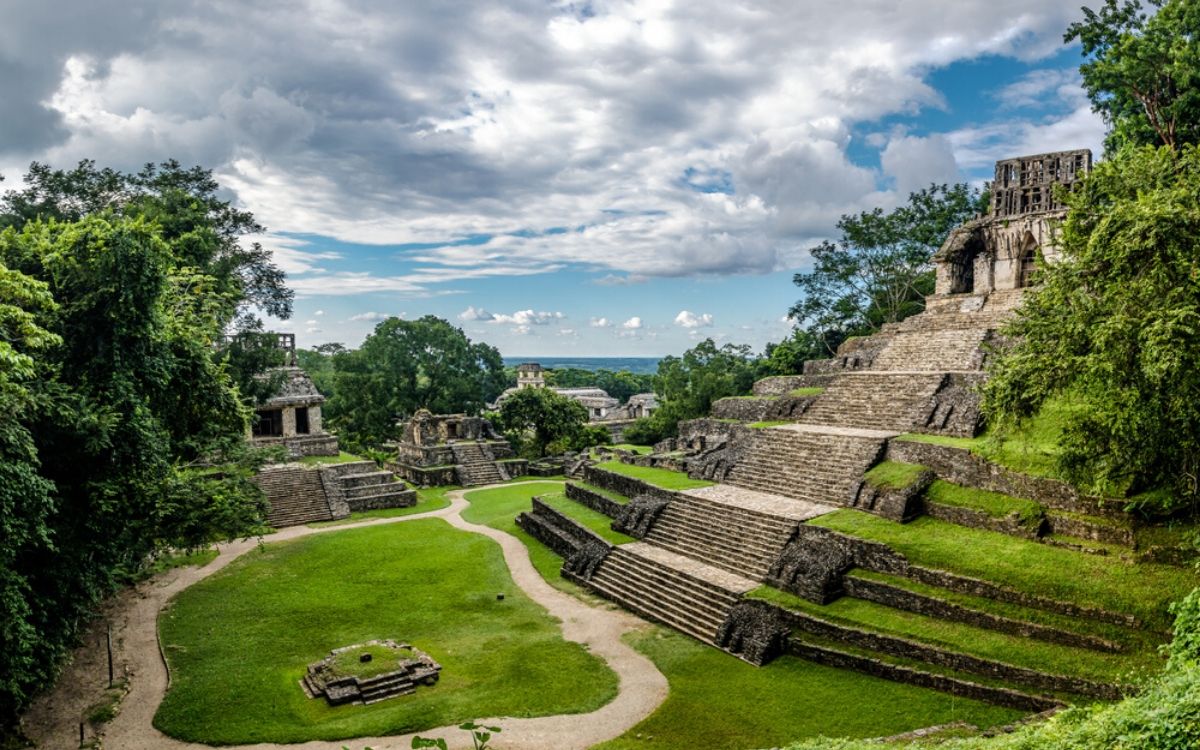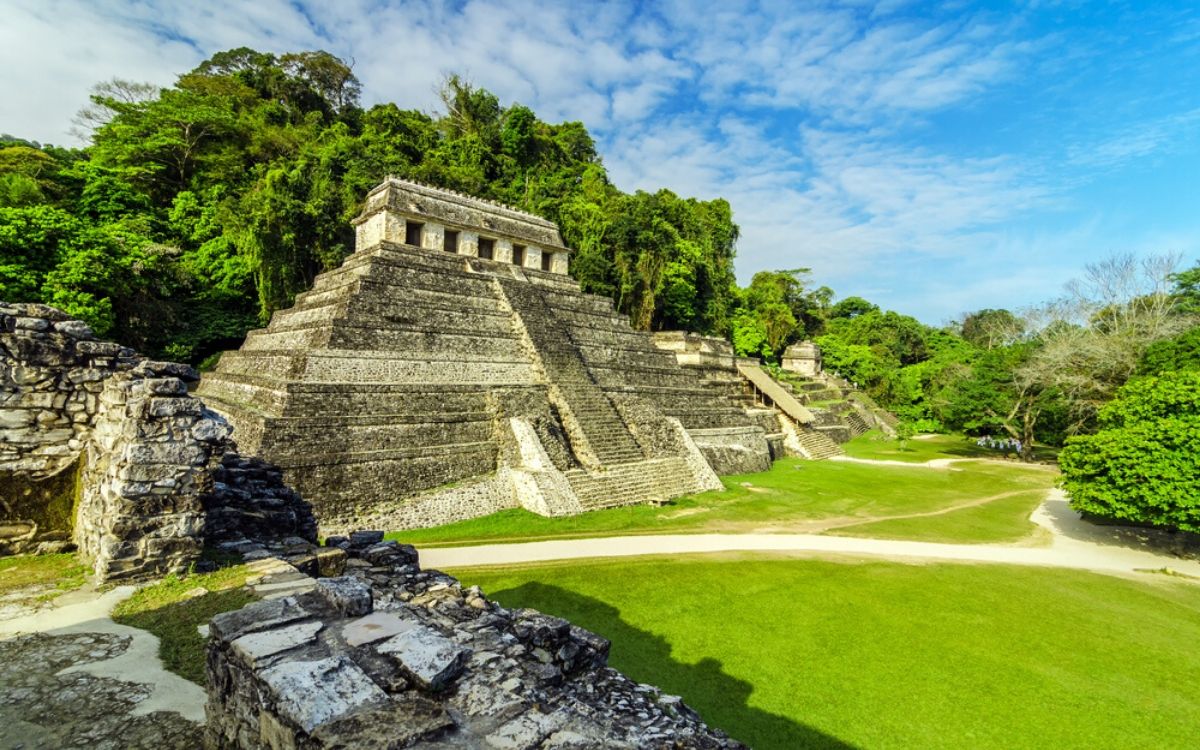Palenque Ruin Site is a Unique and Important Mayan City
The Mayan Ruins of Palenque are as important as Chichen Itza, Uxmal and Tikal in architectural magnificence and historical significance. Located 400 miles (650 kilometers) from the Riviera Maya, this is a great 3 day road trip from the beach. As an UNESCO Heritage site, Palenque is testimony to the mythology and resources of the Maya.
When we made the trip to Palenque, our self-imposed vacation from the beach, the weather was on our side. We made the non-stop drive from Akumal to Palenque in about 12½ hours. Our agenda was to spend time at the Palenque Ruins and experience the exotic mountain state of Chiapas in southern Mexico. Waterfalls, cascades, Mayan ruins, caves, canyons, lagoons and extraordinary wildlife awaited and we took full advantage of what Chiapas has to offer.

Natural Harmony Within the Palenque Settlement
Palenque is located in the Tumbalá mountains, and overlooks the jungle below. The Mayan builders and architects of Palenque balanced landscape with platforms, temples and palaces, which created an artful harmony at the settlement. The Usumacinta River is part of the settlement and created a means of transportation for Palenque citizens. The river also placed Palenque along a main trade route and fed water through man-made canals into the city. The Otulum, a tributary of the Usumacinta, was channeled into an ingenious 50m long canal that crosses through the city. In 2010, archeologists discovered that this canal was pressurized, the first of its kind in the world.
Palenque is one of the most studied and documented Mayan archeological ruins. The known history about Palenque is more than we can provide here. The ongoing debates focus on the interpretation of the hieroglyphics, the gender and role of the many rulers, and how educators decipher and interpret the secrets and evolving facts about the Maya. Undoubtedly, many details remain unknown.
Fast Facts about Palenque Ruins
- UNESCO Heritage site
- Palenque is thought to have been populated from 226 BC to around 799 AD.
- The settlement flourished in the 7th Century under the rule of Pakal.
- The city is surrounded by cedar, mahogany, and sapodilla trees.
- Palenque is a mid-sized settlement that is smaller than Chichen Itza and Tikal.
- The site is 1780 hectares with 1,400 documented buildings, but less than 10% of the city is excavated.
- At its height, Palenque dominated parts of five countries; Belize, El Salvador, Guatemala, Honduras and Mexico.
- The buildings are historically significant for its extensive hieroglyphics that tell stories and show historical facts.
- In 711, Palenque was taken over by Toniná and no new construction was started after 800 A.D.
- The Spanish first arrived in the 1520s and found small communities living throughout the grounds of the settlement.
- Use to ticket to gain free entrance to the Palenque Museum at the bottom of the mountain road. Well worth the visit.

Highlights of the Palenque Ruins
We have listed some highlights of our experience at Palenque. This is just a small introduction to the site with an overview of the structures.
Temples of the Crosses Group – The Temple of the Cross, Temple of the Sun, and Temple of the Foliated Cross are a set of elegant temples in the Palenque site. The temples, located on platforms, each having elaborate carvings and interior chambers that explain rituals and allegiance to Mayan gods.
The Temple of Inscriptions – The Temple of Inscriptions is perhaps the most significant structure on the site. It is a constructed monument built by King Pakal’s first son. King Pakal was appointed the Ruler of Palenque by his mother, Queen Sak Kuk, at the age of 12 years old. Pakal the Great reigned in Palenque from 615 to 683 A.D. and was thought to be the most significant ruler of the city. Upon his death, his first son was appointed ruler and ordered the construction of the Temple of Inscriptions.
The Temple of the Inscriptions has a dual function. The building is a record of approximately 180 years of the city’s history from the 4th through 12th. It is also the place of the King Pakal’s tomb. The stairway from the top of the pyramid to the tomb was discovered by Alberto Ruz in 1952. a discovery that solved a long standing mystery that baffled archaeologists since Stevens and Catherwood documented their visit to Palenque in 1840.
The stairway is a 80 foot vertical descent to Pakal’s burial chamber where an ornately carved stone slab sealed his tomb. The humidity in the tomb is intense, and leaves one thinking that the walls weep for Pakal. Special permissions which could once be obtained have been stopped to this interior part of the Temple of Inscriptions.
What We Love About Palenque
There is a distinct sense of tranquility within Palenque. Take in this experience, as we did, while you walk though the area. The site has areas of shade so it is easy to hang out at the Palenque Ruins for the entire day. One of our favorite things to do in Palenque is to explore the jungle trails that lead to smaller plazas, temples, and limestone cascades. Palenque is a visit worth planning and doing!
Palenque is on many travelers bucket list, as this ruin site provides a unique adventure very different from other southern Mayan sites. The experience leaves a lasting impression that most visitors cannot describe. Not a single traveler has regrets for their planned diversion to Chiapas.
Public transportation will take you to the area, but a rental car makes the adventure far more interesting. We loved our trip and continue to look for opportunities to make our way back to Palenque in search of more information about the Maya.
Update 2015 – We made the road trip again to Palenque and we are still in awe at this site. Arrive early to avoid the crowds and enter the site at the second entrance up the mountain, not the first entrance by the museum. Visitors need to pay an initial entrance fee into the park of 31 pesos and an additional INAH entrance fee into the ruins. There is a new cafeteria at the museum, and a textile shop. Both are great for taking a break. The site has not changed, nor has the tranquility. It is a bit overwhelming when you enter the site, due to vendors, parking attendants, and tour groups, but once you are on the grounds, you are in a world all to yourself. Enjoy this site, it really is everything you could imagine it to be.
